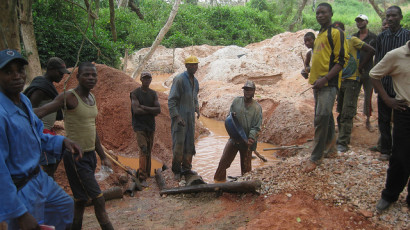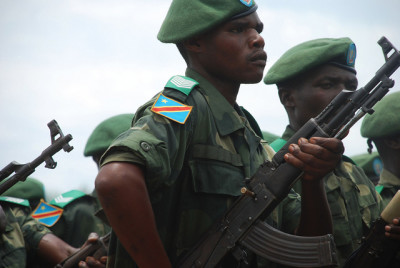By Jacob Kushner February 29, 2016

Colton and tantalum mining in the Democratic Republic of Congo ©Responsible Sourcing Network
The global mineral trade can be ugly. Think children skipping school to dig barefoot with picks and shovels for gold or other precious ore. Picture warlords and army officers using guns to traffic minerals on the black market. Think Democratic Republic of Congo.
Or perhaps, consider the multi-billion dollar corporations that source many of the precious metals they use to build your mobile phone or your laptop from under regulated and often illegal mines. U.S. Congress began thinking about this in 2010 when it passed a first-of-its-kind law aimed at curbing the trade of certain “conflict minerals” in the Democratic Republic of Congo—Africa’s second largest country, whose eastern region has been ravaged by mineral-fueled violence for decades, killing more people than any other conflict since World War II.
Provision 1502 of the Dodd Frank Act requires U.S. companies that source their tin, tantalum, tungsten and gold in Congo to track where, precisely, it comes from, and to publicly declare whether they can guarantee the minerals are conflict-free.
The law was championed by advocacy groups including the Enough Project. But over time, reports surfaced that the regulations were having mixed results, including the unfortunate effect of putting poor Congolese laborers out of work. Recent studies found further that Section 1502 may have simply driven illegal minerals trading deeper into the criminal world, onto the black market. Seventy experts wrote a letter condemning the rule altogether.
Those journalists most familiar with Congo’s mining sector say the entire debate overlooks the fact that the four minerals regulated under the law represent just a small fraction of Congo’s extractive output. The conditions under which copper and cobalt, which make up the majority of Congo’s mineral exports, are extracted were ignored.
Covering Business spoke with Michael Kavanagh, a veteran Bloomberg reporter in Congo who has covered the mineral trade there for more than a decade, about what journalists get wrong and how they can do a better job of covering this complex and divisive subject.
Jacob Kushner: The Enough Project is a popular advocacy group in the United States and has been the primary supporter of the Congo conflict mineral law from the beginning. How did they manage to become the authoritative voice on the matter?
Michael Kavanagh: The Enough Project is very powerful in Washington. John Prendergast (the Founder and Director) has a long history with some of the most powerful people in the government including Susan Rice and Samantha Power, former and current U.S. ambassadors to the UN. He’s also really charismatic and a really good activist. He knows how to sell a story to college kids and he knows how to sell a story to capital hill.
It’s no secret that minerals had been one of the sources of income for armed groups in eastern Congo, which includes the military the army. It’s an old narrative. And the Enough Project turned it into an advocacy campaign. The ‘Do you know there’s blood in your cell phone?’ campaign. And that was very successful.
Kushner: And how did journalists respond?

Congolese soldiers ©The Enough Project
Kavanagh: The major mistake that journalists made in this case, is it became a conversation between the Enough Project and everybody else who doesn’t like the Enough Project. And that’s not the way this conversation should be taking place. It shouldn’t be among advocates and activists, it should be among the people on the ground who are affected.
That means companies, it means Congolese businessmen, foreign business people who work in Congo….the Congolese Chamber of Commerce, the different mining divisions, and obviously the artisanal miners themselves should be part of that story. Journalists’ responsibility in this case is to talk to as many sides as possible. And there are many sides, not just two.
Kushner: Did any good come out of the Enough Project’s highly publicized attempt to curb conflict minerals?
Kavanagh: There are two good things about Dodd-Frank. One, it has brought a lot of attention to a legitimate issue.
And the result of this attention is that we’re finally getting good data from some of these mines for the first time. You have this certification system in place, it helps you understand the smuggling much more—the route of the minerals that are coming and going.
Even if the Enough Project was exaggerating the problem, it was a big problem. And the attention was a good thing.
Kushner: What must journalists remember when they approach a topic like conflict minerals?
Kavanagh: Be really suspicious of just about everyone you talk to when it comes to this issue. The Enough Project has a particular agenda that they don’t want to undermine. They’re cherry picking examples to make it look like Dodd Frank was a success. At the same time, on the other side, you have certain groups like the US Chamber of Commerce that don’t want the cost of it or the potential for reputational damage. So you can’t fully trust them at all. They care mainly about the billions of dollars it costs to implement these regulations.
And at the same time you should be suspicious of the academics and the pundits who have easy answers for these issues, because we lack a lot of data.
Kushner: What are some other mistakes journalists make when covering conflict minerals?
Kavanagh: There’s so much writing about conflict minerals. Inevitably they show a snapshot of a particular place.
For me, it’s not just about whether there’s conflict or not. You also should be worried about child labor, the safety conditions in the mines, the rights of the workers to assemble, to have adequate safety mechanisms, the rights of the communities to reap some kind of benefit from the mining of their land, the rights of those communities to not have environmental damage or to have that environmental damaged cleaned up.
One complication about eastern Congo too, something that everyone needs to keep in mind, is that a lot of that money goes to the Congolese army. It’s not just rebel groups. When representatives of the government are the ones involved in the mining and taxing, it becomes much more complicated.
Kushner: What research can journalists turn to in order to inform their reporting on conflict minerals in Congo and globally?
Kavanagh: Michael Nest’s short book “Coltan,” gives a great picture of the coltan trade, while exposing myths and offering loads of useful information.
Jeroen Cuvelier et al.’s paper, Analyzing the Impact of the Dodd-Frank Act on Congolese Livelihoods, was one of the first big attempts to gather data on the impact of 1502. Cuvelier, Jose Diemel and Koen Vlassenroot also wrote a paper on the Politics of Conflict Minerals, which is very useful.
The UN Group of Experts reports from 2009-present show how bad the situation was in eastern Congo before Dodd Frank, introduces the UN’s suggested due diligence principles, and monitors the trade to this day.
Lastly, IPIS in Belgium is full of stat-heads and map makers and top-notch analysts who produce great reports. And Global Witness has been doing important reporting on the issue for years.
Kushner: For a parachute journalist or someone who reports on the subject without ever even stepping foot in Congo, is it still possible to do a decent job?
Kavanagh: Journalists need to be better about understanding economics, about understanding markets. The minerals that are shipped from eastern Congo (as regulated under Dodd Frank)—the three T’s (tungsten, tantalum, tin) and gold—the amount of revenue the government gets from that is almost nothing; a couple percentage points, 5 or 6 at most. Almost all of Congo’s money comes from the industrial mines—copper, and cobalt.
Journalists need to think of those minerals in the broader Congolese economy. Do you think the Congolese government is really that worried about the 4 or 5 percent of their mining revenue that comes form tin, tantalum, tungsten and gold? Or do you think they’re concerned with the 90 percent that comes from copper and cobalt? We spend so much time looking at these conflict minerals, but the real fight at the government level is about copper.
If you’re trying to make a decision about whether a policy is good or bad but you don’t understand what the sector looks like, how can you make that judgment?
—-
Jacob Kushner is a freelance journalist currently reporting on foreign aid, human rights, extractives in developing nations, and Chinese and other foreign investment in Africa. The latter two were the subjects of his recent eBook, China’s Congo Plan, available for you computer or mobile device from Amazon ($1.99) and Apple ($2.99, with full multimedia).
This entry was posted on Monday, February 29th, 2016 at 4:05 pm. It is filed under On the Beat and tagged with conflict minerals, Democratic Republic of Congo, The Enough Project. You can follow any responses to this entry through the RSS 2.0 feed.
Comments are closed.
